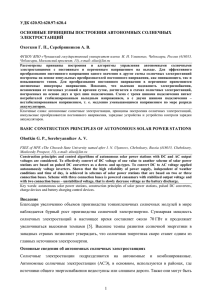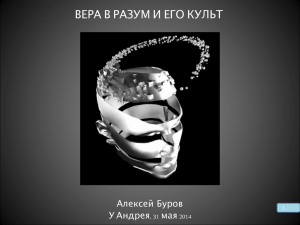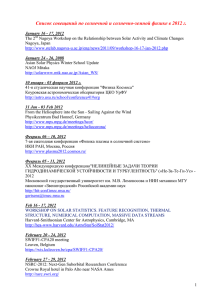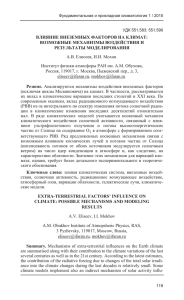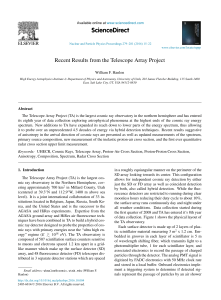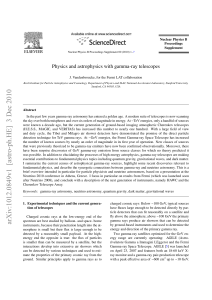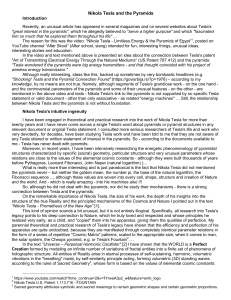Cosmic Rays and Evolution of the Biosphere
реклама
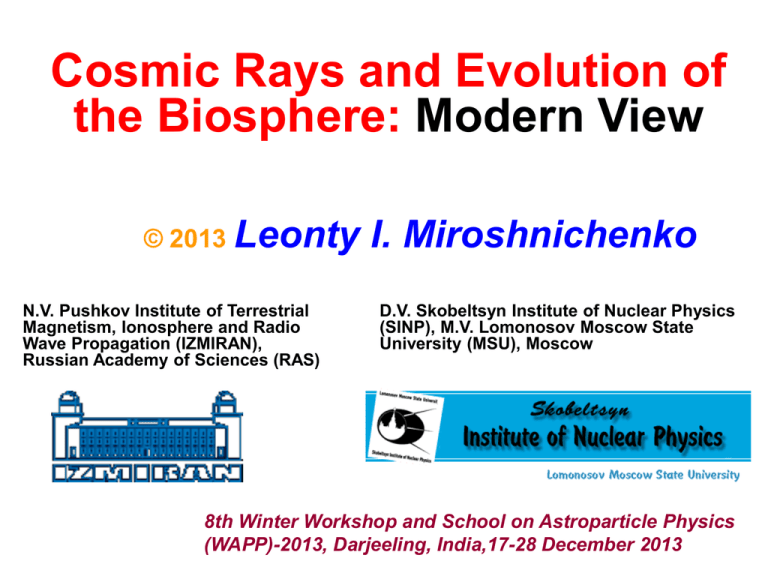
Cosmic Rays and Evolution of the Biosphere: Modern View © 2013 Leonty N.V. Pushkov Institute of Terrestrial Magnetism, Ionosphere and Radio Wave Propagation (IZMIRAN), Russian Academy of Sciences (RAS) I. Miroshnichenko D.V. Skobeltsyn Institute of Nuclear Physics (SINP), M.V. Lomonosov Moscow State University (MSU), Moscow 8th Winter Workshop and School on Astroparticle Physics (WAPP)-2013, Darjeeling, India,17-28 December 2013 Prerequisites/Motivations/Goals • The Earth’s biosphere was born and has developed with permanent ecological factor, namely, with an ever present background of ionizing radiations. The latter are, first of all, natural radioactivity and cosmic rays of galactic and solar origin (GCR and SCR). • Above the Earth’s land surface at middle latitudes the radiation background for 2/3 of magnitude is provided by radioactive substances and for 1/3 - it is due to cosmic rays (CR). Above the ocean surface the radiation background is near completely formed by cosmic rays. • It may be stated that even now the biosphere still continues its evolution under changing radiation conditions due to variation of background CR intensity. • Cosmic rays as one of permanent ecological and biotropical factors. • Goals: Summary/review/revision/analysis of relevant astrophysical, geochemical paleonthological and biological data at modern level of our understanding. Galactic Habitable Zone (GHZ) Typical Spiral Galaxy. Our Galaxy (Milky Way) is structured much like billions of other spiral galaxies. The galactic disk contains a lot of interstellar matter (like dust and gas), as well as young and intermediate-age stars. While young stars can be found scattered throughout the Galaxy, the stellar population tends to be older in the bulge around the galactic center. Image Credit: NASA/STScI • • It has been hypothesized that in an annular region of our Galaxy (Galactic Habitable Zone, see the next slide) the conditions are best suited to the development and survival of life as we know it. The GHZ was first proposed in 1991 by Guillermo Gonzalez (Iowa State University) and Donald Brownlee and Peter Ward (Washington University), and has subsequently been endorsed by a number of other researchers.. Outside the galactic habitable zone (GHZ), the theory goes, various factors make the existence of complex (multicellular) life difficult if not impossible. The current GHZ is said to extend from 7 to 9 kiloparsecs (23,000 to 29,000 light-years) from the galactic center, is widening with time, and is composed of stars that formed between 4 and 8 billion years ago. The GHZ is analogous to the much more well established concept of the habitable zone of a star. Sun/Solar System in GHZ According to the GHZ hypothesis, the width of the GHZ is controlled by two factors. The inner (closest to the center of the galaxy) limit is set by threats to complex life: nearby transient sources of ionizing radiation, including supernovae and gamma ray bursters, and comet impacts. Such threats tend to increase close to the galactic center. The outer limit is imposed by galactic chemical evolution, specifically the abundance of heavier elements, such as carbon. According to one recent definition of the galactic habitable zone, as much as 10 percent of all stars in the Milky Way may have experienced chemical and environmental conditions suitable for the development of complex Earth-type life over the past eight to four billion years for evolutionary development. The Sun/SS in spiral arms Observed and extrapolated structure of the spiral arms (density waves). The gray lines radiating from the Sun's position (upper center) list the threeletter abbreviations of the corresponding constellations. According to Gonzalez, over 95 percent of stars in the Galaxy wouldn't be able to support habitable planets simply because their rotation is not synchronized with the rotation of the Galaxy's spiral arms. It takes the Solar System about 225–250 My to complete one orbit around the Galaxy (a Galactic year), so the Sun is thought to have completed 18–20 orbits during its lifetime (4.5 By) and 1/1250 of a revolution since the origin of humans (0.180-0.200 My). The orbital speed of the Solar System about the center of the Galaxy is approximately 220 km/s or 0.073% of the speed of light. At this speed, it takes around 1,400 years for the Solar System to travel a distance of 1 light-year, or 8 days to travel 1 AU. Sun/SS between other stars The Sun (and therefore the Earth and the Solar System) may be found close to the inner rim of the Galaxy's Orion Arm, in the Local Fluff inside the Local Bubble, and in the Gould Belt, at a distance of 8.33 ± 0.35 kiloparsecs (27,200 ± 1,100 ly) from the Galactic Center.The Sun is currently 5–30 parsecs (16–98 ly) from the central plane of the Galactic disk. The Sun keeps out of the way of the Galaxy’s spiral arms which contain disruptive gravitational forces and radiation. The distance between the local arm and the next arm out, the Perseus Arm, is about 6,500 light-years (2.0 kpc).The Sun, and thus the Solar System, is found in the Galactic habitable zone. Main sequences of the stars in Galaxy The Galaxy “in profile”. Arising matters: What is the most important? • Habitat (environment): Current terrestrial cosmo-biological situation (gravity, radiation, solar activity, geomagnetic field etc.)? • Paradox of the “faint early Sun” – observed discrepancy between paleoclimate data and astrophysical models of the Sun’s evolution. • Variability of solar activity and occurrence rate of solar flares in the epoch of “young Sun”? • Inversions of geomagnetic field in the past? • Cosmic rays and meteorites in the remote past? • Occurrence probability of giant solar flares? • Occurrence rate of SN bursts + Contribution of dwarf stars? To estimate the true CR fluxes coming to the Earth. Let us consider: • Cosmic rays and meteorites in the remote past • Occurrence probability of giant solar flares • Occurrence rate of SN bursts • Contribution of dwarf stars (Pamela data) • Astrobiology, cosmic rays and Martian experiments Isotopes in meteorites: Potassium К-40, Т(1/2) = 1.3 Billion years. Chlorine Cl-36, Т(1/2) = 3.08×10^5 years. A.K. Lavrukhina, 1969; A.K. Lavrukhina, G.K. Ustinova, 1990. (V.I. Vernadsky Geochemistry Institute, RAS Moscow). GCR and Meteorites Relative GCR variations in the past by long-lived products of nuclear reactions in meteorites due to CR bombardment: F(t) – CR flux at remote time t, F(0) – modern level (data for 11 iron meteorites). Cambrian Period, 550-510 MYA (Million Years Ago)… Between ~300-900 Myr ago a summary flux of GCR in the Solar system was ~1/3 of modern level. Meteorites, GCR and Spiral Arms • Current data for the spiral arm passages gives a crossing once every 135 ± 25 Myr. • A record of the long term variations of the galactic cosmic ray flux can be extracted from iron meteorites. It was found that the cosmic ray flux varied periodically (with flux variations greater than a factor of 2.5) with an average period of 143 ± 10 Myr. • This is consistent with the expected spiral arm crossing period and with the picture that the cosmic ray flux should be variable. The agreement is also with the correct phase. • There are some “hints” in the Shaviv’s data that, at least, twice through last 1By cosmic ray flux (CRF) was ~1/3 of modern level – at ~200 Myr and ~800 Myr ago. • Nir J. Shaviv. Cosmic Ray Diffusion from the Galactic Spiral Arms, Iron Meteorites, and a Possible Climatic Connection. Phys. Rev. Lett., 2002, v.89, No.5, p.051102 (1-4). SS passages through Spiral Arms The top panel describes our passages through galactic spiral arms. The second panel describes the predicted CR flux and the predicted occurrence of IAEs (Ice Age Epochs). The third panel describes the actual occurrence of IAEs. The fourth panel indirectly describes the variable CR flux. Due to the fact that the CR flux is the "clock" used to exposure date meteorites, the meteoritic ages are predicted to cluster around periods when the "clock" ticks slower, which is when the CR flux was lowest, as is seen in the data (N.J. Shaviv, 2006). Past Galactic arm crossings A compilation of 74 iron meteorites which were K(41)/K(40) exposure dated (Voshage & Feldman, 1979). To avoid real clustering in the data (due to one parent body generating many meteorites) N.J. Shaviv has removed all occurrences of Fe meteorites of the same classification that are separated by less than 100 Myr and replace them by the average. This left him with 42 meteorites. (Nir J. Shaviv, 2002). Cambrian Explosion of Life • The Cambrian Period, 550-510 million years ago, is often referred to as the dawn of the explosion of life, because it is a time when great diversity of life forms were first recorded as fossils. While multicelled organisms (metazoans) actually evolved much earlier, the story is poorly documented in the fossil record because they did not have protective outer coverings and soft tissue is rarely preserved. • Most modern groups of invertebrates first appeared at the beginning of the Cambrian Period. The major groups were arthropods (animals with joined appendages such as insects, spiders, crabs), echinoderms (spiny skinned animals such as starfish), cnidarians (including corals, jellyfish and sea anemones), and mollusks (clams, snails and squids). Biotic extinctions and giant solar flares • The occurrence rate of giant flares can be also estimated from some circumstantial data. For example, it is suggested (Beland and Russel, 1976) that the recently discovered 4 cases of extinction of Radiolaria for the last 2.5 My were due to the occurrence of such giant flares with a frequency ~ 10^(-4)/year coinciding with the geomagnetic inversion period. • Extrapolating their highest energies (>60 MeV) fit to long time scales, Kiraly and Wolfendale (1999) obtained some new interesting estimates. It turns out that while the highest fluence measured up to now (in about 30 years) was 310^9 cm^(-2), one would expect in 1 My a few events above 10^12 cm^(-2), and in 100 My a few above 10^13 cm^(-2). This is far less than one would expect from flat slopes found by Wdowczyk and Wolfendale (1977), but probably more realistic. Thus, the largest solar particle events in geological history should have been not more than 10^3 to 10^4 times larger than those detected so far, giving rise to only moderate “energetic particle catastrophes”. • Those estimates, however, seem to be overestimated: see below our estimates for the fluences of Φ(≥30 MeV). SN bursts and biotic extinctions • • Relative occurrence rate of Supernova bursts (solid curve) in comparison with a number of marine animal genera becoming extinct during any given time interval. According to Svensmark (2012), the Galaxy let the reptiles down. However, the author’s correction for the ocean level changes rather significantly the original set of data and should be undergo to additional verification. Terrestrial Climate in the Phanerozoic Eon Variations of the concentration of the oxygen isotope 18O (Veizer et al., 1999). On the other hand, there are independent climatic data (Veizer et al., 1999) that points to the variations of the concentration of the oxygen isotope 18O (as one of the best climatic index) at large time scale. All maximums obtained by Veizer et al. (1999) coincide with the Svensmark’s curve. PAMELA Results: New Challenge? • Protons and helium nuclei are the most abundant components of the cosmic radiation. Precise measurements of their fluxes are needed to understand the acceleration and subsequent propagation of cosmic rays in our Galaxy. Adriani et al. (2011) reported precision measurements of the proton and helium spectra in the rigidity range from 1 GV to 1.2 TV performed by the satelliteborne experiment PAMELA (Payload for Antimatter Matter Exploration and Light-nuclei Astrophysics). • It was found that the spectral shapes of these two species are different and cannot be described well by a single power law. • These data challenge the current paradigm of cosmic-ray acceleration in Supernova remnants followed by diffusive propagation in the Galaxy. More complex processes of acceleration and propagation of cosmic rays are required to explain the spectral structures observed in PAMELA data (Adriani et al. Science. 2011, Apr 1; 332(6025):69-72. E-pub. 2011, March 3). • Stozhkov’s hypothesis: In our Galaxy, side by side the Supernovas, there are other sources of CR in the PAMELA energy range. The main candidates of this kind are so-called dwarf stars. Ratio of the proton/helium fluxes versus rigidity by data of PAMELA Proton (left) and helium (right) spectra measured in the range 10 GV-1.2 TV The true CR fluxes near the Earth? • It has been pointed out that there is no record of solar superflares over the past 2,000 yr. According to the measurement of the impulsive nitrate events in polar ice, the largest proton flare event during the past 450 yrs is the Carrington event, which occurred on 1 September 1859. The total energy released in this flare was estimated to be of order 10^32 erg, which is only 1/1,000 of the maximum energy of flares on slowly rotating Sunlike stars. • Maehara H. et al. Superflares on solar-type stars. Nature 24 May 2012, v. 485, 479 – 481. • Flare activity of the Sun is less of ~ (3 - 4) order of magnitude than that of the most active dwarf stars. The latter may serve as cosmic ray sources up to the energies of 1013 - 1014 eV. Life time of CR is ~ 10^7 y. Cosmic rays near the Earth’s orbit from SN bursts and solar flares Integral occurrence rate of SCR events at given energy density at the Earth’s orbit (top plots). Estimates of ionization contribution from SN gamma-flash (bottom plots) at the distance of 10 parsec from the Earth (flash) and from protons for the periods of Earth’s stay in SN remnant during 3 years (3 yr) and during all the time (all time). Wdowczyk and Wolfendale, 1977. Ionization effects from energetic particles (GCR and SCR) and electromagnetic emissions (Xand gamma rays from SNe). Distribution function of SEP events • Recently, some progress in the specification of the distribution function of SEP events in the range of Low Probabilities was achieved due to new results of the study of Greenland Ice Cores (GIC). Important (unique) data on the fluences of large SEP events in the past were obtained for the period of 1561-1950 (McCracken et al., 2001; Townsend, 2003). • In particular, it was estimated a fluence of protons of ≥30 MeV for the largest SEP event of that period registered on 1-2 September 1859 (Carrington event). • Φ(≥30 MeV) = 1.88×10^10 protons/cm^2. Solar Extreme Event of 1859 Peak flux #/(cm**2*s*sr) 1E+7 Integral energy spectrum of 1E+6 A peak (maximum) fluxes of 1E+5 protons for the Carrington 1E+4 B 1E+3 event of 1-2 September 1E+2 1859 (solid blue line with 1E+1 stars), together with r.m.s. 1E+0 deviations (dashed blue 1E-1 1E-2 lines). 1E-3 Red line - Upper Limit 1E-4 Spectrum (ULS) for Solar 1E-5 1E-6 Cosmic Rays (SCR) by 1E-7 Miroshnichenko (1994, 1E-8 1996); green triangles 1E-9 1E-10 ULS corrected by 1E-1 1E+0 1E+1 1E+2 1E+3 1E+4 1E+5 Miroshnichenko & Nymmik MeV (2013, in press). Probabilities of extreme events 1E+1 Probability Distribution function of SEP events on the 1E+0 fluences of Φ(≥30 1E-1 MeV): points with the 1E-2 statistical errors – measurement data 1E-3 onboard the spacecraft 1E-4 IMP-8 and GOES; blue 1E-5 diamonds – estimates by the data from 1E-6 Greenland ice core; 1E-7 solid red line – 1E-8 distribution function (3); triangles – our 1E-9 estimates of Φ(≥30 1E-10 MeV) by Kiraly and 1E-11 Wolfendale (1999) 1E+6 1E+7 1E+8 1E+9 1E+10 1E+11 1E+12 1E+13 data. Ф (#/cm**2) GCR + SCR bombard Mars • Detection of the organic matter on Mars is one of the main goals of the current and future Martian landing missions. However, as noted by Pavlov et al. (2012), the degradation of organic molecules by cosmic ray irradiation on Mars is often ignored. The authors calculated the accumulation rates of radiation dose from solar and galactic cosmic rays at various depths in the shallow Martian subsurface. • It was shown that a 1 Gyr outcrop on Mars accumulates the dosage of ~500 MGy (MegaGrey) in the top 0÷2 cm and ~50 MGy at 5÷10 cm depths. It means that the preservation of ancient complex organic molecules in the shallow (~10 cm depth) subsurface of rocks could be highly problematic if the exposure age of a geologic outcrop would exceed 300 Myr. On the other hand, it was demonstrated that more simple organic molecules with masses ~100 amu should have a good chance to survive in the shallow subsurface of rocks. • P.S. Martian magnetic field is ~ 1/500 of terrestrial one? Astrobiology, cosmic rays and Martian experiments Exposure time (a) at 1 cm and (b) at 5 cm depths necessary for a 1000-fold decrease in the organic molecules abundance vs. molecular mass of the organic compounds. The “standard” Martian surface rock composition and 7 mbar atmosphere were assumed for calculations of GCR contribution. Calculations of the organic degradation due to SCR assume that the atmospheric pressure drops to 0.2 mb for 10% of Martian history in the last billion years (for more details see Pavlov et al., 2012). Earth – Mars: Atmospheres and magnetic fields • • • • • • Earth: Standard pressure P = 760 mm Hg = 1013.246 mbar = 1033.23 g/cm^2. Horizontal component of geomagnetic field at geomagnetic equator (Allen, 1964) – about 0.32 Gs (0.29 - 0.40 Gs). Modern estimate: 0.31÷ 0.58 Gs = (3.1 ÷ 5.8) × 10^4 nT. Mars: The diameter of Mars is 6,800 km across. This is 53% the diameter of Earth. The mass of Mars is only 10% the mass of Earth. Because of the small diameter and low mass, the surface gravity on Mars is only 38% the gravity on Earth. If you weighed 100 kg on Earth, you would weigh 38 kg on Mars. A day on Mars lasts 1.03 Earth days. So humans could actually probably adapt to the day length on Mars. And the axial tilt on Mars is 25.19 degrees. Very close to Earth’s 23.5 degree tilt. This means that Mars has seasons where are very similar to Earths. Of course, since a year on Mars lasts about twice as long as an Earth year, the seasons are twice as long. There are two major reasons why the climate on Mars is hostile to life as we know it. Temperatures on Mars can dip down to -87 degrees C, and rarely get above 0 degrees C. But the biggest pressure is the lack of an atmosphere. The atmosphere of Mars is less than 1% the thickness of Earth’s atmosphere. Furthermore, it’s made up of 95% carbon dioxide – this is poisonous to breathe. Martian magnetic fields • The current upper limit on the dipole moment remains at ~ 10^(-4) times that of Earth. Today, the only other “direct” information on Martian magnetism is from a special class of meteorites which are thought to come from Mars. Magnetic field analyses of possible samples of the Martian crust indicate that magnetic fields of ~ 1000 nT may have been present on the surface of Mars at the time that these meteorites were ejected by a giant impact some 180 million years ago. For comparison, the present field on Earth near the equator is about 3 × 10^4 nT. The present upper limit on the dipole moment implies surface fields of only a few tens of nanotesla. • In some ways, Mars compared to Earth is actually quite similar, but in most ways, Mars is a totally different world, not suitable for humans to live on its surface without our technology. Probability to survive… The GHZ in the disk of the Milky Way based on the star formation rate, metallicity (blue), sufficient time for evolution (gray), and freedom from lifeextinguishing supernova explosions (red). The white contours encompass 68% (inner) and 95% (outer) of the origins of stars with the highest potential to be harboring complex life today. The green line on the right is the age distribution of complex life and is obtained by integrating P(r, t) over r. Here P(GHZ) is a probability to survive… Charles H. Lineweaver, Yeshe Fenner, Brad K. Gibson. The Galactic Habitable Zone and the Age Distribution of Complex Life in the Milky Way. (Science, Jan 2, 2004). Evolution-Adaptation Syndrome? • Modern response of biological systems to cosmophysical factors (solar-terrestrial disturbances) may be considered as an ancient “atavistic reaction” on the changes of habitat conditions, i.e. as an Evolution-Adaptation Syndrome (EAS). • This concept enables to change in wide range the energies, forms and mechanisms of effective external influence in the development of theoretical models of the biosphere evolution in the remote past (e.g., in the epoch of «young Sun»). “We will never meet them…” • A new paper by Falguni Suthar and Christopher McKay (NASA Ames) “The Galactic Habitable Zone in Elliptical Galaxies,” International Journal of Astrobiology (published online 16 February 2012). • One of the comments (Henk): “We will never meet one of those beings, maybe it is better that we will never meet them. We will never fight war against them. I think that inteligent life is very rare, but not as rare that we are alone…” • Thank you… Acknowledgements • This work is partially supported by RAS_28 Program of Fundamental Research “Problems of the life origin and formation of the biosphere” (Russian Academy of Sciences). • Some important references: Л.И. Мирошниченко. ФИЗИКА СОЛНЦА И СОЛНЕЧНО-ЗЕМНЫХ СВЯЗЕЙ. Под ред. М. И. Панасюка. Москва, НИИЯФ МГУ: Университетская книга, 2011. - 174 с., 90 рис., 8 табл., цветн. ил.- ISBN 978-5-91304-191-3; lib.qserty.ru/static/tutorials/133_Miroshnichenko_2011.pdf В.Н. Обридко, Л.И. Мирошниченко, М.В. Рагульская, О.В. Хабарова, E.Г. Храмова, М.М. Кацова, М.А. Лившиц. Космические факторы эволюции биосферы: Новые направления исследований. - Проблемы эволюции биосферы. Серия «Гео-биологические системы в прошлом». М.: Палеонтологический Институт (ПИН) РАН, 2013. С. 66–94 (Труды конференции, посвящённой памяти академика Г.А. Заварзина, 21-22 марта 2012 г.). http://www.paleo.ru/institute/files/biosphere.pdf L.I. Miroshnichenko. Cosmic Rays and Evolution of the Biosphere: Search for New Approaches. – Proc. Int. Conference “Space Weather Effects on Humans in Space and on Earth”. Space Research Institute, Moscow, 4-8 June 2012. Editors: A.I. Grigoriyev, L.M. Zeleny. 2013, v.1, p.110-136. See Web-site of SRI: http://www.iki.rssi.ru/print.htm 33 Contact information • Dr. LEONTY I. MIROSHNICHENKO • Sector of Helio-Ecological Relations • Department of Physics of SolarTerrestrial Relations, N.V. Pushkov Institute IZMIRAN, Troitsk, Moscow Region, PB 142190, RUSSIA • Phone: 007(495)851-02-82; 007(495)93958-68; 007(495)851-23-61 • Fax: 007(495)851-01-24 • E-mail: [email protected] Abstract_1 In fact, cosmic rays flux from the Galaxy is undergone to considerable spatial and temporal changes. The cause of such changes may be the Supernova bursts. In turn, the SCR fluxes depend on the occurrence rate and power of solar flares. Combined impacts of GCR and SCR on the near-terrestrial space, finally, are strongly determined by the level of solar activity (SA) at present. Moreover, those effects might considerably depend on the SA level in the remote past of the Earth, during the epoch of the “young Sun”. Abstract_2 On the other hand, it was found by present time that GCR and SCR have played an important role in different processes in the Earth’s atmosphere. The latter are: ionization and excitation of the atmospheric atoms, depletion of the ozone layer, production of the nitrogen oxides (nitrates), operation of the global electric circuit, formation of electric charge in the clouds and generation of lightning strokes, formation of cloudiness and precipitation falls. In geological past of the Earth the CR effects on the atmosphere might be also closely tied with the variations of geomagnetic field. Hence it follows a possible relation between CR, solar activity, geomagnetic field and terrestrial climate that, in turn, determines indirect impact of CR on the biosphere. • Meanwhile, for several decades a hypothesis is discussed on possible direct impact of CR on the biospheric processes, in particular, on the occurrence rate of mutations for some organisms. This effect may be due to arrival of intense flux of CR from the Supernova burst that happened near the Solar system. Note, however, that after-effects of such radiation exposure may be different for different species of the biosphere. For example, if enhanced radiation in the dinosaur’s epoch might be a cause of their extinction, for some other animals and plants considerable increase of CR intensity could serve as a factor that favoured to their further evolution. • Abstract_3 • • • • • Of special interest is so-called Cambrian explosion in the biosphere (~540 My ago) when, according to some meteoritic data, CR intensity was about 1/3 of modern level. As to giant solar flares of the 23 February 1956 type, according to some estimates, might be a cause of four extinctions of Radiolaria within last ~2.5 My, especially in the case of coincidence of the flare events with the periods of geomagnetic inversions. In some recent experiments, there were noted effects of secondary neutrons from CR on the cell structures (for example, during a series of solar proton events in October 1989). It is important that GCR of extreme energies (E ≥ 10^15 eV) with a high probability may initiate the lightning strokes in the atmosphere, and this factor, in turn, could stimulate the formation from simple organic compound of complicated molecular complexes - “building blocks” of the life at the Earth. In the whole, from astrophysical point of view, it would be timely, in particular, to estimate anew the probabilities of SN bursts and giant solar flares, taking into account accurately the transport time of CR from their sources to the Earth etc. As to the radiobiologists and genetics, they will have, to our mind, to carry out new modeling studies with taking into account new real information about cosmic ray variations in the past and in the present time. Young Sun and Biosphere • Стандартная модель эволюции звёзд утверждает, что 4 млрд. лет назад Солнце излучало приблизительно на 30 % меньше энергии, чем сейчас. При таких условиях вода на поверхности Земли должна была бы полностью замёрзнуть. В то же время, геологические исследования архейских осадочных пород показывают, что в ту эпоху на Земле был влажный и теплый климат. В условиях глобального оледенения, возможно, не смогла бы возникнуть жизнь. • Большинство учёных склоняются к объяснению этого парадокса глобальным парниковым эффектом, действовавшем в ранней истории Земли, и вызванным очень высокими концентрациями вулканических газов, таких как углекислый газ и метан. Впервые эту модель предложили и количественно анализировали советские ученые Л.М. Мухин и В.И. Мороз. • It is of great interest to study the “ancient” acceleration processes which took place during the early evolution stage of the Sun when it was an active young star of the T-Tauri type, with a strong solar wind and a flare activity 10^3 – 10^5 times as high as at present (Caffee et al., 1987). Energetic particles near the Earth’s orbit Дифференциальные энергетические спектры протонов и некоторых других ионов (слева) и электронов (справа) различного происхождения по наблюдениям на орбите Земли. Для сравнения справа приведен также типичный спектр ускоренных вспышечных протонов (Lin, 1980). Primary and Secondary Cosmic Rays in the Earth’s Atmosphere Historical SNe and nitrate oxides Nitrate in polar ice • Nitrate concentration in the South Pole core representing ~1200 years (a), and the time equivalent upper part of the Vostok core (b). Historical SNe are indicated for the respective nitrate anomalies. Minimum errors (~10 years for South Pole record; ~30 years for Vostok record) are indicated by error bars (Dreschhoff and Laird, 2006). Nitrate concentration profile from the Windless Bight core on the Ross Ice Shelf (Antarctic) by the data of Kansas University, USA (Dreschhoff and Zeller, 1990). The x-axis is proportional to true depth below the surface; the y-axis represents nitrate concentration in mg per unit of the entire length of the core. At least three major flares occurred in 1928 (“white” solar flare in July), 1946 (GLE on 25 July), and 1972 (two GLEs on 4 and 7 August) are visible in the records as large concentration peaks. The increases above the series mean are 7, 11 and 4 standard deviations, respectively. Наталья Константиновна Белишева • Апатиты, Полярный Геофизический Институт. • Докторская диссертация (2005): • “Значение вариаций геокосмических агентов для состояния биосистем” • Cell merging correlates with Ground Level Enhancements of SCR: Due to secondary neutrons? Воздействие космических лучей на живые системы Эффекты воздействия нейтронов на клеточные культуры во время солнечных протонных событий в октябре 1989 г. A B Клеточные культуры линии L в спокойный период (1) и во время солнечных событий (2) . 1 2 Cell merging Нейтронный монитор, ст.Апатиты (А), ядерно-активные частицы на земной орбите и динамика индексов слияния клеток линий L, CHO, FHM (Б) Между возрастанием солнечных космических лучей на земной орбите, нейтронным счетом на поверхности Земли и слиянием клеток существует достоверная корреляция (p0,01). CR and Lightning strokes • A.D. Erlykin and A.W. Wolfendale. Long term time variability of cosmic rays and possible relevance to the development of life on Earth. Survey of Geophysics, 31:4 (2010), 383–398. ГКЛ высоких энергий могут при попадании в атмосферу вызывать развитие ядерно-электромагнитных каскадов, называемых широкими атмосферными ливнями (ШАЛ). Плотность заряженных частиц особенно велика в центральной области каскада, называемой стволом ШАЛ. Протон с энергией 1 ПэВ (10^15 эВ), падающий вертикально на атмосферу, создаёт в максимуме развития каскада и на расстоянии 1м от его оси ШАЛ плотность порядка 3000 м-2. При прохождении ШАЛ через атмосферу он оставляет след ионизованного воздуха, в плазме которого присутствуют тяжёлые ионы и электроны. Если такой ливень проходит в районе грозовых облаков с высокой напряжённостью электрического поля, то в области его ствола может развиваться пробой на убегающих электронах. Эти идеи подтверждаются как теоретическими расчётами, так и результатами экспериментальных проверок. Хотя эти проверки находятся пока что на начальной стадии, можно утверждать что какая-то часть молниевых зарядов действительно инициирована ШАЛ. Если в далёком прошлом интенсивность КЛ высоких энергий, инициирующих ШАЛ, была значительно выше современной, то можно ожидать, что в эти периоды частота молниевых разрядов превышала наблюдаемую сейчас. В Восточных Хрониках есть указания на то, что в районе Корейского полуострова за период 1400-1900 гг. частота молний в начале периода была в 3-7 раз выше, чем в конце. Short-term variations of CR over the period of 1 million years by statistical model (Erlykin and Wolfendale, 2001). The bin width is 1000 y. CR and «buildings blocks» of life: Formation of complex molecules • An analysis is made of the manner in which the cosmic ray intensity at Earth has varied over its existence and its possible relevance to both the origin and the evolution of life. Much of the analysis relates to the 'high energy' cosmic rays (E>10^{14}eV = 0.1PeV) and their variability due to the changing proximity of the Solar system to Supernova remnants which are generally believed to be responsible for most cosmic rays up to PeV energies. • It is pointed out that, on a statistical basis, there will have been considerable variations in the likely 100 My between the Earth's biosphere reaching reasonable stability and the onset of very elementary life. Interestingly, there is the increasingly strong possibility that PeV cosmic rays are responsible for the initiation of terrestrial lightning strokes and the possibility arises of considerable increases in the frequency of lightnings and thereby the formation of some of the complex molecules which are the 'building blocks of life'. (Erlykin and Wolfendale, 2010). CR and lightning rate • Attention is also given to the well known generation of the oxides of nitrogen by lightning strokes which are poisonous to animal life but helpful to plant growth; here, too, the violent swings of cosmic ray intensities may have had relevance to evolutionary changes. A particular variant of the cosmic ray acceleration model, put forward by us, predicts an increase in lightning rate in the past and this has been sought in Korean historical records. • Finally, the time dependence of the overall cosmic ray intensity, which manifests itself mainly at sub-10 GeV energies, has been examined. The relevance of cosmic rays to the 'global electrical circuit' points to the importance of this concept (Erlykin and Wolfendale, 2010). • “To go from a bacterium to people is less of a step than to go from a mixture of amino acids to a bacterium”. — Lynn Margulis, interviewed in The End of Science, by John Horgan. Addison-Wesley Publ. Co., Inc., 1996. p 140-141. Lightning and nitric oxides • Perhaps less speculatively is the role of NOx (NO + N2O) generated by lightning strokes. It seems that nearly 20% of the contemporary concentration of NOx is produced by lightning. • Its rate of production would certainly vary considerably. NOx is poisonous to mammals but promotes growth in plants. Thus, an effect on evolution of species, both positive and negative, is likely (Erlykin and Wolfendale, 2010). Considerable amounts of nitric oxides are produced also by solar cosmic rays (e.g., Crutzen et al., 1975). Relevant References • • • • • • • • 1. V.I. Krassovskij and I.S. Šklovskij. Variation of the intensity of cosmic radiation during Earth’s geological history and their possible influence on life’s evolution. – Supplemento al volume VIII, serie X del Nuovo Cimento, No.2, 1958, p.440-443. 2. Wdowczyk, J. and Wolfendale, A.W.: 1977, Cosmic rays and ancient catastrophes, Nature, v.26, No.5620, 510-512. 3. P. Király and A.W. Wolfendale. Long-Term Particle Fluence Distributions and Short-Term Observations. 26th ICRC, Salt Lake City, USA, 1999, v.6, p.163-166. 4. Н.К. Белишева, Е.З. Гак. Значение вариаций космических лучей для функционирования живых систем. Сб. научных докл. VII Межд. конф. "Экология и Развитие Северо-Запада России» 2-7 августа 2002 г., Санкт-Петербург. С.118-129. 5. A.D. Erlykin and A.W. Wolfendale. Long term time variability of cosmic rays and possible relevance to the development of life on Earth. arXiv:1003.0082v1 [27 February 2010]. Survey of Geophysics, 31:4 (2010), 383–398. 6. Caffee, M., Goswami, J.N., Hohenberg, C.M., and Swindle, T.W.: 1987, Solar flare irradiation in meteorites provides evidence for an early active Sun, Proc. 20th Int. Cosmic Ray Conf., Moscow, USSR, 4, 299-302. 7. Beland, P. and Russel, D.A.: 1976, Biotic extinctions by solar flares, Nature, 263, 259. 8. Crutzen, P.J., Isaksen, I.S.A., Reid, G.C., 1975. Solar proton events: Stratospheric sources of nitric oxide. Science, 189, No.4201, 457-458. References-1 • • • • • • • • • • • • 1. Л.И. Мирошниченко. Космические лучи в межпланетном пространстве. М., Наука, сс.160, 1973. 2. O.V. Bol'shakova, L.I. Miroshnichenko, and V.A. Troitskaya. Steady fluctuations of the Earth's magnetosphere, condition for propagation of solar cosmic rays and before the flare situation on the Sun. – In: Cosmic Rays, No 19. Moscow, Nauka, 1978, p.69-80. 3. L.I. Miroshnichenko. Biological effects of cosmic rays. - In: Mutagenesis on Exposure to Physical Factors. Moscow, Nauka, 1980, p.187-205 (in Russian). 4. L.I. Miroshnichenko. Solar cosmic rays in the system of solar - terrestrial relationships. - In: Problems of Solar-Terrestrial Relationships. Ashkhabad, 1981, p.42-62 (in Russian). 5. Мирошниченко Л.И. Солнечная активность и Земля. М., Наука, 1981. 6. L.I. Miroshnichenko. Spectrum of solar cosmic radiation and dynamics of radiation hazard in space. - Kosmicheskaya Biologiya i Aviakosmicheskaya Meditsina, 1983, v.17, No.3, p.8-13. 7. L.I. Miroshnichenko. Variations of cosmic rays in the biosphere. - In: Electromagnetic Fields in the Biosphere. Moscow, Nauka, 1984, v.1, p.33-39 (in Russian). 8. Л.И. Мирошниченко, В.М. Петров. Динамика радиационной опасности в космосе. М., Энергоатомиздат, 1985, cc.152. 9. Мигулин В.В., Мирошниченко Л.И., Обридко В.Н. Солнечно-земная физика: Проблемы и перспективы. - Вестник АН СССР, 1987, №10, с.83-89. 10. S.V. Anisimov and L.I. Miroshnichenko. Electricity in the atmosphere. - Zemlya i Vselennaya (Earth and Universe), 1989, No.4, p.14-22 (in Russian). 11. L.I. Miroshnichenko. Solar cycle 22: Helio-geophysical events of 1989-1990. – Aerokosmicheskaya Tekhnika, 1990, No.8, p.71-75 (in Russian). References-2 • • • • • • • • • • 12. L.I. Miroshnichenko. Cyclic variations and sporadic fluctuations of solar cosmic rays. – Biofizika, 1992, v.37, No.3, p.452-466. 13. L.I. Miroshnichenko. SOLAR COSMIC RAYS. - Kluwer Academic Publishers, The Netherlands, 2001, pp.480. 14. L.I. Miroshnichenko. RADIATION HAZARD IN SPACE. - Kluwer Academic Publishers, The Netherlands, 2003, pp.248. 15. L.I. Miroshnichenko. Shocks in the near heliosphere: Solar-terrestrial disturbances in October-November 2003. - Our Sky, Kiev, 2004, №5/6, p.19-22 (in Ukrainian). 16. A.S. Kirillov, Yu.V. Balabin, E.V. Vashenyuk, Kh. Fadel, and L.I. Miroshnichenko. Effect of solar protons on the middle atmosphere composition during GLE of 13 December 2006 . – Proc. 30th Int. Cosmic Ray Conf., Merida, Mexico, 2007, v.1, p.773776. 17. Miroshnichenko L.I. Solar Cosmic Rays in the System of Solar-Terrestrial Relations (Review). – J. Atm. Solar-Terrestrial Phys. (Special Issue of ISROSES Proceedings), 2008, v.70, p.450-466. 18. L.I. Miroshnichenko. Solar-terrestrial relations in the 23rd cycle of solar activity. – Odessa. Astronomical Calendar. Odessa, Astroprint, 2009, p.164-171 (in Russian). 19. Л.И. Мирошниченко. Проблема «Солнце-Земля»: Современные концепции и физические механизмы. «Космічна Наука і Технологія» (in Russian). Киев, 2011, т.17, №1, с.17-22. 20. Мирошниченко Л.И. Физика Солнца и солнечно-земных связей. Учебное пособие. М., Издательство МГУ, 2011, cc.175. 21. L.I. Miroshnichenko and R.A. Nymmik. Extreme fluxes in Solar Energetic Particle events: Methodical and physical limitations. – Radiation Measurements, 2013 (in press). Stozhkov’s ideas by Pamela results • • "Наша гипотеза состоит в том, что в нашей Галактике, наряду со сверхновыми, источниками космических лучей в области тех энергий, где работает “PAMELA", являются так называемые карликовые звезды", - говорит ученый. Он уточнил, что карликовые звезды относятся к тому же типу, что наше Солнце. Они не обладают большой светимостью и имеют примерно такие же массы, как Солнце. "Мы знаем, что на Солнце происходят вспышки, которые становятся источниками частиц. Многие карликовые звезды гораздо более активны, чем наше Солнце, и могут ускорять частицы до энергий в тысячи и более ГэВ", - сказал Стожков. • • Он пояснил, что такие звезды в нашей Галактике составляют основное население, их более 90% от всех звезд. Однако из-за их слабой светимости мы можем их видеть лишь на небольших расстояниях. Science, 2011, Apr 1; 332 (6025):69-72. Our Real Knowledge/Truth Ratio about the Universe Above-water: Baryon Matter: ≈ 4%. Under-water: Dark Matter ≈ 22%; Dark Energy ≈ 74 %. With the new generation of missions and/or instruments: We shall learn more!..

